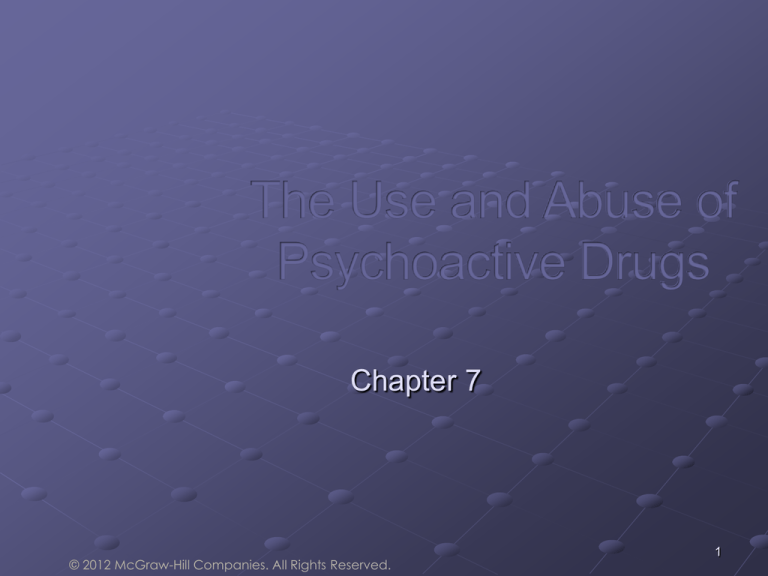
Chapter 7
© 2012 McGraw-Hill Companies. All Rights Reserved.
1
Psychoactive Drugs
A drug which alters a person’s
experiences or consciousness
Can cause intoxication
A state in which sometimes unpredictable
physical and emotional changes occur
© 2012 McGraw-Hill Companies. All Rights Reserved.
2
What Is Addiction?
Addiction traditionally used only when the
habitual use of a drug produced chemical
changes in the user’s body
Tolerance: body’s adaptation to drug
Concept of addiction as a disease
process, based in brain chemistry rather
than moral failing, led to many advances
Addictive behaviors are habits that have
gotten out of control, resulting in negative
effects on a person’s health
© 2012 McGraw-Hill Companies. All Rights Reserved.
3
Characteristics of Addictive
Behavior
Reinforcement
Compulsion or Craving
Loss of Control
Escalation
Negative Consequences
© 2012 McGraw-Hill Companies. All Rights Reserved.
4
Addictive Behavior
The development of addiction
Often starts when person does something to bring
pleasure or to avoid pain
Characteristics of people with addictions
Difficulty dealing with stress and painful emotions
Risk-takers, impulse control problems
Examples of addictive behaviors:
Compulsive gambling
Compulsive exercising
Work addiction
Sex and love addiction
Compulsive buying or shopping
Internet addiction
© 2012 McGraw-Hill Companies. All Rights Reserved.
5
Drug Use, Abuse, and Dependence
Drugs are chemicals other than food that
are intended to affect the structure or
function of the body
Prescription medicines
Over-the-counter substances
Caffeine
Tobacco
Alcohol
Illegal substances
© 2012 McGraw-Hill Companies. All Rights Reserved.
6
Drug Abuse
The APA’s Diagnostics and Statistical Manual of
Mental Disorders – authoritative reference
Abuse: APA definition
Recurrent drug use, resulting in failure to fulfill
major responsibilities
Drug use in situations that are physically
hazardous
Drug-related legal problems
Drug use despite persistent social or
interpersonal problems
Physical dependency may or may not present
© 2012 McGraw-Hill Companies. All Rights Reserved.
7
Drug Dependence
Substance dependence
1.
2.
3.
4.
5.
Developing tolerance to the substance
Experiencing withdrawal
Taking in larger amounts
Expressing a persistent desire to cut down
Spending great deal of time getting, using, or
recovering from the substance
6. Giving up or reducing important activities
7. Continual usage despite the knowledge of a problem
Diagnosis with at least 3 or more symptoms
during a 12-month period
© 2012 McGraw-Hill Companies. All Rights Reserved.
8
Who Uses Drugs?
Drug Users
All income and education levels
All ethnic groups
All ages
People more likely to try drugs
Young people are at a higher risk
Males (Twice as likely)
Troubled adolescents
Thrill-seekers
Members of dysfunctional families
Members of peer groups that accept drug use
People who live in disadvantaged areas
Teen girls who date older boys
© 2012 McGraw-Hill Companies. All Rights Reserved.
9
Why Do People Use Drugs?
Experiment
Escape
Coping
Reliance
Social surroundings
© 2012 McGraw-Hill Companies. All Rights Reserved.
10
Risk Factors for Dependence
Psychological risks
Difficulty in controlling impulses
Strong need for excitement,
stimulation, automatic gratification
Feelings of rejection
Hostility
Aggression
Anxiety
Depression
Mental illness
© 2012 McGraw-Hill Companies. All Rights Reserved.
11
Other Risks of Drug Use
Intoxication
Unexpected side effects
Unknown drug constituents
Risks associated with injection drug use
Legal consequences
© 2012 McGraw-Hill Companies. All Rights Reserved.
12
How Drugs Affect the Body
Changes in Brain chemistry
Drug factors:
Pharmacological properties
Dose-response function
Time-action function
Drug use history
Method of use
User Factors
Social Factors
© 2012 McGraw-Hill Companies. All Rights Reserved.
13
Representative Psychoactive
Drugs
Opioids (narcotics)
Natural or synthetic
Opium, morphine, heroin, methadone, codeine,
hydrocodone, oxycodone, meperidine, and
fentanyl
Effects
Medical Uses
Methods of administration
Injection, snorting, sniffing, or smoking
Symptoms of overdose
© 2012 McGraw-Hill Companies. All Rights Reserved.
14
Representative Psychoactive
Drugs
Central Nervous System Depressants
(Sedative Hypnotics)
Slow down the overall activity of the CNS
Types
Barbiturates (“downers”)
Sedatives or tranquilizers
Effects
Medical uses
From use to abuse
Overdosing
© 2012 McGraw-Hill Companies. All Rights Reserved.
15
Central Nervous System Stimulants
Speed up the activity of the nervous or
muscular system
Cocaine
Methods of use
Effects
Abuse and dependence
Use during pregnancy
© 2012 McGraw-Hill Companies. All Rights Reserved.
16
Central Nervous System Stimulants
Amphetamines (“uppers”)
Effects
From use to abuse
State dependence
Dependence
Methamphetamine
Ritalin
Caffeine
© 2012 McGraw-Hill Companies. All Rights Reserved.
17
Marijuana and Other Cannabis
Products
Cannabis Sativa
THC (tetrahydrocannabinol)
Short-term effects and uses
Depersonalization
Long-term effects
Respiratory damage
Dependence
© 2012 McGraw-Hill Companies. All Rights Reserved.
18
Hallucinogens
LSD, mescaline, psilocybin, STP, DMT,
MDMA, ketamine, PCP (angel dust), and
certain mushrooms
Effects
Altered states of consciousness, perceptions,
feelings and thoughts
LSD effects
Synesthesia
Altered states of consciousness
Flashbacks
© 2012 McGraw-Hill Companies. All Rights Reserved.
19
Inhalants
Types
Volatile solvents
Aerosols
Nitrites
Anesthetics
Methods of use
Sniffing
Snorting
“Bagging”
“Huffing”
Effects
Nearly all inhalants produce effects similar to those of
anesthetics, which slow down body functions
© 2012 McGraw-Hill Companies. All Rights Reserved.
20
Drug Use: The Decades Ahead
Drug research
Drugs, society, and families
Legalizing drugs
Drug Testing
© 2012 McGraw-Hill Companies. All Rights Reserved.
21
Treatment for Drug Dependence
Medication-assisted treatment
Drug substitution
Treatment centers
Self-help groups and peer counseling
AA
NA
Harm reduction strategies
Codependency
© 2012 McGraw-Hill Companies. All Rights Reserved.
22
Preventing Drug Abuse
Governmental attempts
Anti-drug education programs
Indirect approaches
Building young people’s self-esteem
Improving their academic skills
Increasing their recreational opportunities
Direct approaches
Informing them about the adverse effects of
drugs
Peer pressure resistance
© 2012 McGraw-Hill Companies. All Rights Reserved.
23
Chapter 7
© 2012 McGraw-Hill Companies. All Rights Reserved.
24






